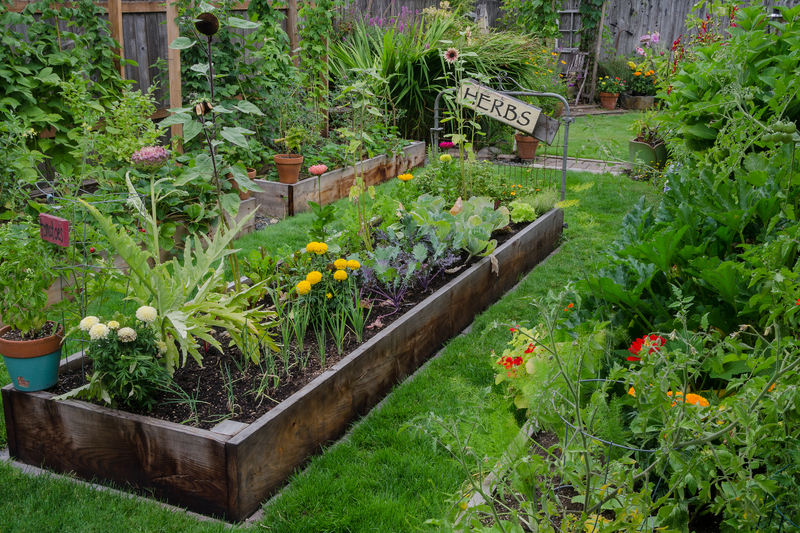Turning Green Waste into a Nutrient Powerhouse for Soil
Posted on 14/06/2025
Turning Green Waste into a Nutrient Powerhouse for Soil
Green waste is an underutilized resource in our homes, gardens, and landscapes. By effectively transforming this organic material, we can create a nutrient powerhouse for soil that supports plant growth, improves soil structure, and benefits the environment. In this comprehensive article, you will learn how to turn green waste into a valuable soil amendment, the science behind green waste composting, key methods, and best practices to maximize results.

What Is Green Waste?
Green waste refers to biodegradable organic material generated by gardens, lawns, and parks. It primarily consists of:
- Grass clippings
- Leaves
- Vegetable and fruit scraps
- Young weeds (before they have seeded)
- Prunings and plant trimmings
- Coffee grounds and tea leaves
This fresh, moist matter is rich in nitrogen and essential enzymes, making it ideal for boosting soil fertility when managed correctly. Turning green waste into compost is one of the best ways to recycle it and enrich your soil.
Why Transform Green Waste into a Soil Nutrient Powerhouse?
Disposing of green waste in landfills can contribute to methane emissions, a potent greenhouse gas. By converting it into a soil amendment, you help reduce landfill use and create a cycle of resource reuse. Green waste composting yields several soil and plant benefits:
- Boosts Soil Structure: Compost improves aeration, water retention, and drainage.
- Increases Soil Fertility: Compost adds vital macro and micronutrients for plant health.
- Enhances Microbial Activity: Microbes in compost help plants access nutrients and protect against disease.
- Reduces Need for Chemical Fertilizers: Less reliance on synthetic additives means healthier, more sustainable gardens.
- Promotes Sustainability: Closing the loop by returning nutrients to the soil supports both environmental and economic health.
The Science Behind Turning Green Waste into a Nutrient-Rich Soil Amendment
The process of transforming green waste into a nutrient powerhouse is called composting. This is a natural, biological process where microorganisms such as bacteria, fungi, and actinomycetes decompose organic material. A basic compost heap requires three primary elements:
- "Greens" (Nitrogen Rich): Grass clippings, fruit and vegetable scraps, coffee grounds
- "Browns" (Carbon Rich): Dry leaves, straw, cardboard, wood chips
- Moisture and Airflow: Water and oxygen are critical for microbial activity
Maintaining the right balance of carbon to nitrogen (C:N ratio, ideally about 30:1) ensures efficient breakdown of material. Too much green waste (high nitrogen) can cause odors, while too many browns (high carbon) can stall decomposition.
Stages of Composting
- Mesophilic Stage: Initial breakdown at moderate temperatures
- Thermophilic Stage: High-heat phase (up to 70?C or 160?F) where pathogens and weed seeds are destroyed
- Maturation Stage: Cooling and curing phase, humus formation completes
Each phase is crucial as the green waste transforms into a stable, soil-enhancing compost.
Methods for Converting Green Waste into Soil Nutrients
There are several proven methods to turn green waste into nutrient-rich soil. Each technique has its unique advantages:
Traditional Composting
Backyard composting involves collecting green and brown organic waste in a dedicated bin or pile. The mixture is turned regularly to introduce oxygen and speed up decomposition. After 3-9 months, the material is converted to dark, crumbly compost. This resulting compost can be used in garden beds, vegetable plots, and around trees.
Vermicomposting
Worm composting utilizes red wigglers (Eisenia fetida) to break down green organic waste quickly. Worms create castings, a highly potent soil amendment packed with nutrients and beneficial microbes. Vermicompost is excellent for vegetable gardens, houseplants, and delicate seedlings.
Mulching
Sometimes, green waste such as grass clippings or shredded leaves can be directly applied as mulch. Mulch suppresses weeds, retains soil moisture, regulates temperature, and as it slowly decomposes, releases nutrients into the soil.
Hot Composting
Hot composting accelerates the process by optimizing material size, moisture level, and aeration. With the right mix, temperatures rise quickly, and compost matures in 4-12 weeks. This method rapidly converts large volumes of green waste into a nutrient-rich powerhouse.
Bokashi Composting
Bokashi is an anaerobic (oxygen-free) fermentation method utilizing beneficial microbes to quickly break down green waste, including cooked food scraps. It produces a pre-compost that can be buried in soil to finish decomposing, rapidly enriching soil nutrients.
Best Practices for Composting Green Waste
To maximize nutrient content and soil benefit, follow these essential composting tips:
- Maintain balance: Aim for about 2 parts brown to 1 part green (30:1 C:N ratio).
- Chop waste: Smaller particles decompose faster and more evenly.
- Aerate regularly: Turning the pile prevents odors and encourages aerobic decomposition.
- Monitor moisture: Compost should feel like a wrung-out sponge--not too wet, not too dry. Add water or more greens if dry, browns if sopping.
- Avoid problem items: Skip diseased plants, weeds with seeds, large woody material, meat, and dairy.
- Patience and observation: Composting takes time. Be patient and adjust as needed for local climate and materials.
Common Issues and Solutions
- Bad Odors: Usually caused by too much green waste or excess moisture. Add brown materials and aerate.
- Slow Decomposition: Small pile, lack of nitrogen, or dryness can cause slow progress. Add more greens, water, and turn the pile.
- Rodent Intrusion: Avoid including cooked food or meat. Use bins with secure lids.
How Finished Compost Becomes a Nutrient Powerhouse in Soil
Well-matured compost is teeming with life and nutrients. Let's explore what makes it such an asset:
- Gradual Nutrient Release: Compost provides a slow, steady supply of macronutrients (N-P-K) and micronutrients (Ca, Mg, Fe, Zn, Cu, Mn, B, Mo, Cl), feeding plants over growing seasons.
- Improved Soil Texture: Compost binds sandy soils, improves clay permeability, and provides structure for roots.
- Increased Water Retention: Enhanced soil absorbs and holds more water, reducing irrigation needs.
- Soil Microbial Diversity: Healthy compost inoculates soil with beneficial bacteria and fungi, suppressing pathogens and nutrient lockup.
- Pest and Disease Resistance: Compost-fed plants are stronger, with better immunity and resilience.
Applying 1-3 inches of compost or worm castings to gardens, lawns, and pots annually can yield healthier, more productive plants while promoting natural soil cycles.
Environmental and Economic Benefits of Green Waste Composting
Transforming green waste into a soil nutrient resource has wider advantages beyond your own garden:
- Methane Reduction: Diverting organics from landfill cuts greenhouse gas emissions.
- Landfill Space Preservation: Lower waste volumes mean less land used for waste disposal.
- Reduced Chemical Use: Healthier soil needs fewer synthetic fertilizers and pesticides.
- Economic Savings: Free, high-quality compost reduces landscaping and gardening costs.
- Climate Resilience: Soils rich in organic matter buffer against drought, floods, and erosion.
Industrial Solutions: Large-Scale Green Waste to Soil Processing
Commercial composting facilities and municipal green waste programs process vast quantities of material via windrow, aerated-static pile, or in-vessel systems. Resulting products--compost, mulch, or soil blends--are sold to farmers, landscapers, and the public.
How Can Communities Participate?
- Advocate for curbside green waste pickup.
- Support local composting centers.
- Purchase compost-enriched soil products for use in landscaping and gardens.
- Host or join community composting projects to engage residents and reduce local waste.
Innovative Approaches: Enhancing the Nutrition Profile of Green Waste Compost
Simple steps can further enrich compost beyond the basics:
- Rock dust: Adds trace minerals, correcting nutrient deficits in depleted soils.
- Biochar: Improves carbon storage, microbial habitat, and nutrient retention.
- Seaweed or kelp: Provides a complete spectrum of microelements, growth hormones, and polysaccharides.
- Mycorrhizal inoculants: These specialized fungi expand plant root absorption, increasing nutrient uptake from compost.
- Anaerobic teas or extracts: Liquid "compost teas" applied as foliar sprays or soil drenches offer a rapid nutrient and microbial boost.
Customizing your nutrient mix ensures your soil receives a full spectrum of needed elements, pushing compost's benefits even further.

Green Waste Compost for Specific Soil or Plant Needs
Different plants and soils thrive with tailored compost blends. Here are expert pointers:
- Vegetable gardens: Rich, well-aged compost boosts heavy feeders like tomatoes, cabbage, and squash.
- Acid-loving plants (blueberries, azaleas): Mix compost with pine needles or peat moss for slightly lower pH.
- Lawns: Top-dress with finely screened compost for a lush, green turf.
- Flower beds: Use compost as a mulch to feed perennials and annuals while protecting roots.
- Improving poor soil: Several applications of compost help transform sandy or clay soils into productive beds.
Conclusion: Turn Your Green Waste Into Gold for the Soil
Green waste isn't merely a material to discard--it's a potential nutrient powerhouse for soil, waiting to be unlocked with the right approach. By composting at home, supporting local green waste recycling, or simply mulching garden beds, you close the loop of sustainability and regenerate your soil's fertility.
With each handful of compost, your garden grows more resilient, productive, and environmentally friendly. Commit to transforming your green waste, and watch your soil--and the benefits--grow richer by the season.
Quick tips for a thriving compost pile:
- Balance your greens and browns.
- Keep it moist, but not soggy.
- Turn regularly for good aeration.
- Let nature do the work, and start reaping the rewards.
Ready to turn your yard waste into plant superfood? Start your compost pile today, and create a self-sustaining, nutrient-rich powerhouse for your soil--naturally.

